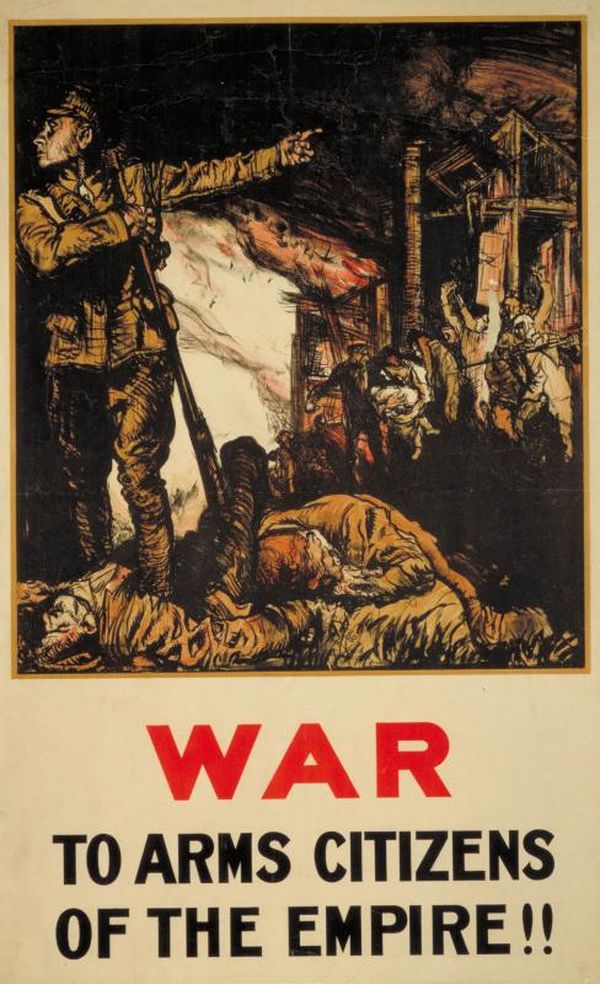
London Transport at War: Recruitment Posters from the First World War
In previous blogs I focussed on a number of posters from the First World War and Second World War that featured the subtle and not so subtle use of propaganda. In this blog I have selected three Underground Group posters that very clearly appealed to the consciences of young men, staff and Underground passengers alike, though only one of the three posters features the ‘UndergrounD’ logo.
The graphic scenes and messaging portrayed in these posters amount to clear propaganda in support of the national war effort. The Underground Group was still a private group of companies so the way this messaging tallied with posters published by the British government demonstrates the prevailing dominant mood at the time.
Britain declared war on Germany on 4 August 1914. Many believed what became the First World War would all be over by Christmas 1914. For the first two years of the war, young men were vigorously encouraged by sustained national publicity to serve their country by joining the armed forces. By 1915 over one million men had volunteered, but more were needed. This resulted in the introduction of conscription in 1916, meaning compulsory military service for men aged between 18 and 41, unless they were exempt.
War – to arms citizens of the Empire, Frank William Brangwyn, 1914
Frank William Brangwyn was a prolific artist from Wales with a broad range of artistic skills including lithography. He produced several posters for the Underground Group and London Transport. In this example from the first year of the First World War, the grim reality of the conflict is depicted in this stark design.
The poster was clearly aimed at appealing to the consciences of young men, encouraging them to volunteer for the armed forces. Like much British propaganda at the time, it did this by referencing the destruction wrought on Belgium by the invading German Army. A British soldier points to a burning Belgian town, with dead civilians on the ground and others attempting to flee. Britain had largely justified declaring war on Germany on the basis of a commitment to defending neutral Belgium, through which Germany had invaded to attack France.
The image in the poster is derived from a larger lithographic design by Brangwyn, published in the Underground’s largest four sheet format, which has a wider scene.
The only road for an Englishman, Gerald Spencer Pryse, 1914
Gerald Spencer Pryce specialised in lithography as an art form. He took the text from this Underground poster personally to heart and became a despatch rider himself for the Belgian government in the early part of the First World War. His experiences caused him to produce an ‘exact record’ of the fighting, as he saw it, in a series of lithographs in 1914. Pryce described travelling with lithographic stones, so he could draw direct to the stone for his resulting prints. He later served as an officer in the British Army, fighting in the Third Battle of Ypres in 1917. Between 1913 and 1921 Pryce produced a small number of commissions for the Underground Group including this one.
The poignancy of the statement, ‘The only road for an Englishman’, is reinforced by the two flanking statements, ‘Through Darkness to Light’ and ‘Through fighting to Triumph’, all broadcasting unconcealed patriotism. The overall drab and colourless effect delivers power to the text whilst the soldiers’ sober stance would suggest their readiness for action and stoicism as they march through a ruined town.
Join the army today, artist unknown, 1915
In this poster, photos with text referencing recent activities of the Army and Royal Navy combine with the three stark comments that are aimed at civilians. Headed with the black and white ‘Underground’ logo and ‘tiled’ lettering, this poster was aimed primarily at passengers travelling on the network. The branding also made clear the Underground Group’s support of wider British wartime messaging in encouraging all of society to contribute to the war effort, including men joining the armed forces.
This example shows how this format of poster, leaving space for changing and up-to-date photographs of the war’s progress in 1915, could also incorporate different messaging. All three text elements here encourage men to join the Army, using an element of humour and also reflecting the common association of between fighting in the First World War and sport. For those already fighting in the grim conditions of the Western Front, the reality was somewhat different.
With the introduction of conscription in 1916, there was no longer a need for posters – whether published by the government or by private organisations like the Underground Group – to encourage men to enlist. However, amid the mounting casualties and as the war dragged on, posters were increasingly used to maintain the wider war effort at home.
You can see more of our poster collection online, on a Depot guided tour or at our Depot Open Days - the next one, Depot Unlocked, will be from 22-25 September 2022.





